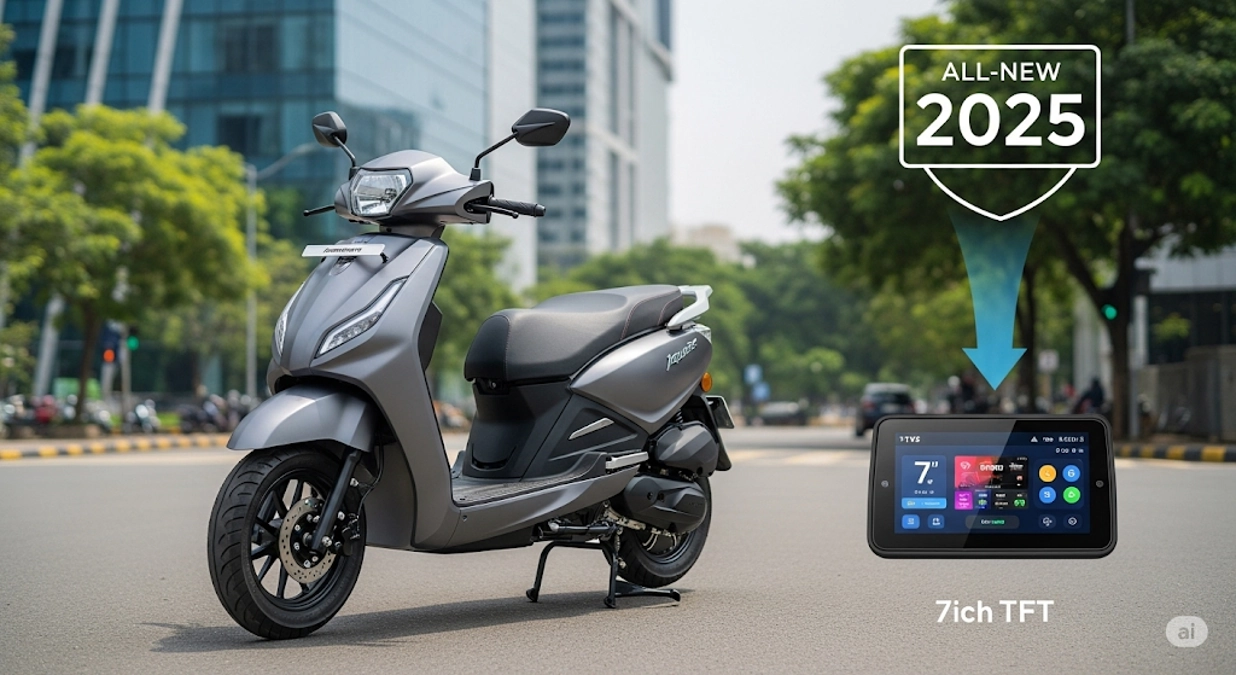New Delhi: The electric scooter battlefield is set for its most dramatic showdown yet. TVS has unleashed its heavily updated 2025 iQube lineup, and the message is clear: the range anxiety era is over. Spearheaded by a flagship ST variant boasting a staggering 212 km of real-world range (and a claimed 280 km IDC), TVS is not just entering the fray; it’s aiming for a knockout. With a refreshed lineup spanning multiple battery packs and price points, starting from a highly competitive ₹95,000 (ex-showroom), the new iQube family is a direct challenge to the supremacy of segment titans like the Ather 450X, Bajaj Chetak, and Ola S1 Pro. This is more than just an update; it’s a calculated assault on the premium electric scooter market.
Key Features at a Glance
| Specification | 2025 TVS iQube (Top ST 5.3 kWh Variant) |
| Battery Pack | 5.3 kWh (Largest in segment) |
| Real-World Range | ~212 km (Claimed IDC) |
| Top Speed | 82 km/h |
| Charging Time | ~4 hours (0-80%) |
| Key Features | 7-inch TFT Touchscreen, TPMS, 32L Storage |
| Ex-Showroom Price | Starting from ₹95,000 (for 2.2 kWh variant) |
Price Breakdown: What You’ll Actually Pay
TVS has adopted a brilliant multi-tiered pricing strategy for the 2025 iQube, making it accessible to a wide range of buyers. While the base 2.2 kWh model starts at an aggressive ₹95,000, the top-of-the-line ST 5.3 kWh variant is expected to be priced around ₹1.60 lakh (all prices ex-showroom).
The on-road price, which includes state subsidies (if applicable), RTO charges, and insurance, is what you will ultimately pay. Here are our expert estimates for the on-road prices of the popular TVS iQube variants in major Indian cities:
| City | iQube (3.5 kWh) | iQube ST (5.3 kWh) |
| Delhi | ~₹1.25 Lakh | ~₹1.80 Lakh |
| Mumbai | ~₹1.22 Lakh | ~₹1.77 Lakh |
| Bengaluru | ~₹1.20 Lakh | ~₹1.75 Lakh |
| Chennai | ~₹1.23 Lakh | ~₹1.78 Lakh |
(Note: These are estimated on-road prices and can vary based on state subsidies, RTO taxes, and insurance premiums.)
2025 TVS iQube vs. Its Biggest Rivals
The premium electric scooter segment is a clash of titans. The new iQube, with its multiple variants, now challenges each of its key rivals on their own turf. Here’s how the top-spec iQube ST stacks up.
| Feature | TVS iQube ST (5.3 kWh) | Ather 450X (3.7 kWh) | Bajaj Chetak Premium | Ola S1 Pro (Gen 2) |
| Price (Ex-Showroom) | ~₹1.60 Lakh | From ₹1.57 Lakh | From ₹1.46 Lakh | From ₹1.36 Lakh |
| Battery (kWh) | 5.3 kWh | 3.7 kWh | 3.2 kWh | 4 kWh |
| Claimed Range | 212 km | 150 km | 126 km | 195 km |
| Top Speed | 82 km/h | 90 km/h | 73 km/h | 120 km/h |
| Key Feature/Weakness | Feature: Unmatched range & storage. Weakness: Lower top speed. | Feature: Superlative handling & performance. Weakness: Less comfortable ride. | Feature: Premium metal body & build quality. Weakness: Slower performance & charging. | Feature: Best-in-class performance & features. Weakness: Inconsistent software experience. |
Our Verdict: Who Should Buy It?
The 2025 TVS iQube lineup is a masterstroke of strategy, offering a tailored solution for almost every type of electric scooter buyer.
The 2025 TVS iQube is the perfect scooter for you if: You are a practical, family-oriented buyer who prioritizes range, comfort, and reliability above all else. The new top-end ST variant, with its massive 212 km range, is a game-changer for those with longer commutes or a desire for weekend trips without charging anxiety. The scooter’s comfortable suspension, spacious 32-litre under-seat storage, and trusted TVS service network make it the most sensible and family-friendly premium electric scooter on the market. The lower-priced variants are perfect for city-bound commuters who want a reliable and well-built EV from a legacy brand without breaking the bank.
While the Ather 450X will continue to attract performance enthusiasts with its sharp handling, and the Ola S1 Pro will appeal to the tech-savvy who crave raw speed, the TVS iQube solidifies its position as the undisputed king of practicality and peace of mind.
Frequently Asked Questions (FAQ)
What is the real-world range of the new TVS iQube ST 5.3 kWh?
While the ARAI-certified IDC range is 212 km, the real-world range will likely be around 170-180 km on a single charge in mixed riding conditions, which is still the highest in its segment.
Is the TVS iQube faster than the Ola S1 Pro?
No. The Ola S1 Pro is significantly faster, with a top speed of 120 km/h compared to the iQube ST’s 82 km/h. The iQube prioritizes range and ride comfort over outright top speed.
Does the base model of the TVS iQube have the same features as the top model?
No, the lineup is tiered. The base 2.2 kWh model comes with a 5-inch TFT display and essential smart features. The higher ST variants get a larger 7-inch TFT touchscreen, a Tyre Pressure Monitoring System (TPMS), and more advanced connectivity features.
How does the iQube’s build quality compare to the Bajaj Chetak?
Both scooters are very well-built. The Bajaj Chetak is lauded for its all-metal body, giving it a premium and robust feel. The TVS iQube uses high-quality plastics and has excellent fit and finish, reflecting TVS’s long-standing reputation for durable products.
